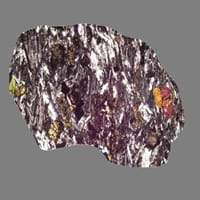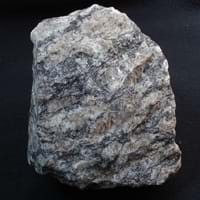Definition
Trachyte is a grey fine-grained volcanic rock which mainly consists of alkali feldspar
Gneiss is a common and widely distributed type of rock formed by high-grade regional metamorphic processes from pre-existing formations that were originally either igneous or sedimentary rocks
Discoverer
Alexandre Brongniart and René Just Haüy
Unknown
Etymology
From Greek trakhus rough’ or trakhutēs roughness
From the Middle High German verb gneist (to spark; so called because the rock glitters)
Class
Igneous Rocks
Metamorphic Rocks
Sub-Class
Durable Rock, Medium Hardness Rock
Durable Rock, Hard Rock
Group
Volcanic
Not Applicable
Other Categories
Fine Grained Rock, Opaque Rock
Coarse Grained Rock, Medium Grained Rock, Opaque Rock
Texture
Aphanitic to Porphyritic
Banded, Foliated, Platy
Color
Black, Brown, Dark Greenish - Grey, Green, Grey, Light to Dark Grey, White
Black, Brown, Pink, Red, White
Durability
Durable
Durable
Scratch Resistant
Yes
Yes
Appearance
Banded
Foliated
Interior Uses
Decorative Aggregates, Flooring, Homes, Interior Decoration
Countertops, Decorative Aggregates, Flooring, Interior Decoration
Exterior Uses
As Building Stone, As Facing Stone, Paving Stone, Garden Decoration, Office Buildings
As Building Stone, As Facing Stone, Garden Decoration, Paving Stone
Other Architectural Uses
Curbing
Curbing
Construction Industry
As Dimension Stone, Building houses or walls, Cement Manufacture, Construction Aggregate, for Road Aggregate, Landscaping, Making natural cement, Manufacture of Magnesium and Dolomite Refractories
As Dimension Stone
Medical Industry
Not Yet Used
Not Yet Used
Antiquity Uses
Artifacts, Monuments, Sculpture, Small Figurines
Artifacts
Commercial Uses
Cemetery Markers, Creating Artwork
Cemetery Markers, Jewelry, Tombstones, Used in aquariums
Types
Not Available
Augen Gneiss, Henderson Gneiss, Lewisian Gneiss, Archean and Proterozoic Gneiss.
Features
Available in Lots of Colors and Patterns, Is one of the oldest rock, Matrix variable
Generally rough to touch, Is one of the oldest rock
Archaeological Significance
Famous Monuments
Data Not Available
Konark Sun Temple in India, Washington Monument, US
Sculpture
Used
Not Yet Used
Famous Sculptures
Data Not Available
Not Applicable
Pictographs
Used
Not Used
Petroglyphs
Used
Not Used
Figurines
Used
Not Yet Used
Formation
Trachyte is an igneous volcanic rock with an aphanitic to porphyritic texture. It is the volcanic equivalent of syenite rock and forms as a result of magmatic differentiation.
Gneiss is a high grade metamorphic rock i.e. it has been subjected to higher temperatures and pressures than schist. It is formed by the metamorphosis of Gneiss forms from volcanic rock, shale or granitie.
Mineral Content
Augite, Biotite, Feldspar, Hornblade, Plagioclase, Quartz
Biotite, Chlorite, Feldspar, Garnet, Graphite, Hornblade, Micas, Muscovite or Illite, Quartz, Quartzite, Silica, Zircon
Compound Content
Potassium Oxide, Sodium Oxide, Silicon Dioxide
Aluminium Oxide, NaCl, CaO, Iron(III) Oxide, FeO, Potassium Oxide, Magnesium Carbonate, MgO, MnO, Phosphorus Pentoxide, Silicon Dioxide, Titanium Dioxide
Types of Metamorphism
Cataclastic Metamorphism, Contact Metamorphism, Regional Metamorphism
Impact Metamorphism
Types of Weathering
Biological Weathering, Chemical Weathering, Mechanical Weathering
Biological Weathering, Mechanical Weathering
Types of Erosion
Chemical Erosion, Coastal Erosion, Glacier Erosion, Sea Erosion, Water Erosion, Wind Erosion
Chemical Erosion, Coastal Erosion, Sea Erosion
Grain Size
Fine Grained
Medium to Coarse Grained
Fracture
Not Available
Irregular
Porosity
Less Porous
Very Less Porous
Cleavage
Not Available
Poor
Toughness
Not Available
1.2
Specific Gravity
2.7
2.5-2.7
Transparency
Opaque
Translucent to Opaque
Density
2.43-2.45 g/cm3
2.6-2.9 g/cm3
Resistance
Heat Resistant, Impact Resistant, Wear Resistant
Heat Resistant, Pressure Resistant, Scratch Resistant, Wear Resistant
Deposits in Eastern Continents
Asia
China, India, Iran, Saudi Arabia, Sri Lanka, Taiwan, Thailand, Turkey, Vietnam
China, India, Iran, Iraq, Kazakhstan, Kyrgyzstan, Mongolia, Russia
Africa
Angola, Egypt, Madagascar, Namibia, Nigeria, South Africa
Cameroon, Ethiopia, Ghana, Kenya, Madagascar, Morocco, Mozambique, Namibia, Nigeria, Tanzania, Togo
Europe
Bulgaria, England, Germany, Norway, Romania, Switzerland
Albania, Austria, Bosnia and Herzegovina, Finland, France, Georgia, Germany, Hungary, Italy, Kosovo, Monaco, Norway, Poland, Romania, Serbia, Slovakia, Slovenia, Switzerland, Ukraine, United Kingdom
Others
Not Yet Found
Not Yet Found
Deposits in Western Continents
North America
USA
Canada, Costa Rica, Cuba, Mexico, Panama, USA
South America
Brazil, Chile
Argentina, Bolivia, Brazil, Chile, Colombia, Ecuador, Peru, Venezuela
Deposits in Oceania Continent
Australia
New Zealand, Queensland, South Australia, Western Australia
New South Wales, New Zealand, Queensland, Victoria










